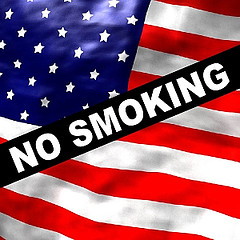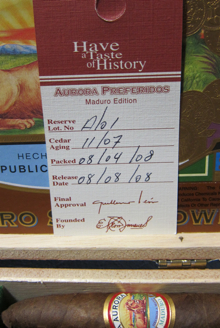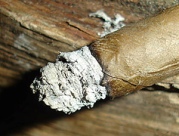Stogie Commentary: World No Tobacco Day vs. Memorial Day
2 Jun 2010
If you’re like me, you probably thought this past Monday was Memorial Day, a day for pausing to think about the men and women who gave their lives to protect the freedoms we take for granted. As I did, you may have also celebrated the unofficial start of summer with some time spent outdoors, around the barbecue, and enjoying a fine cigar or two.
 But, for the bureaucrats at the World Health Organization (WHO), May 31 wasn’t Memorial Day. Rather, it was “World No Tobacco Day“—a day for promoting the policies they call “Tobacco Control.”
But, for the bureaucrats at the World Health Organization (WHO), May 31 wasn’t Memorial Day. Rather, it was “World No Tobacco Day“—a day for promoting the policies they call “Tobacco Control.”
No time to celebrate freedom, the WHO issued a Call to Action, with such action items as implementing a complete ban on advertising of tobacco; enacting total workplace smoking bans that presumably include restaurants, bars, and even tobacco shops; and creating “gender-specific tobacco control policies.”
For those of you at home counting, those are calls to violate such fundamental American principles as freedom of speech, property rights, and equal protection under the law, respectively. And it’s all part of the international organization’s “Tobacco Free Initiative” which, as it sounds, seeks to stamp out the so-called “tobacco epidemic.”
The contrast couldn’t be starker. The day we honor U.S. soldiers who gave their lives for our country, often fighting against authoritarian dictatorships, anti-tobacco forces seek worldwide enactment of laws designed to strip citizens of their choice to enjoy even an occasional cigar.
One can’t help but look back through history, when America sent soldiers to battle with a daily ration of tobacco. In World War II, a K-Ration, or daily combat ration, included four cigarettes. On the other side of the battle field, Hitler despised smoking (which he saw as a filthy Jewish habit) and led Nazi Germany to enact the first modern smoking ban.
No, they aren’t Nazis, but in today’s struggle between freedom and oppressive collectivism, international bureaucrats use the projects like the Tobacco Free Initiative at the United Nations to infringe on fundamental individual rights. Meanwhile, our troops continue to put themselves in harms way as they seek to uphold their oath to the Constitution and the individual liberties that it stands for.
That’s why I hope you joined me in honoring our troops on Memorial Day. And if you also happened to smoke a cigar as part of your Memorial Day, then all the better. Now, why not take the opportunity to donate some cigars to the troops? That’s what the last Monday in May is supposed to be all about, not stamping out our freedom to smoke.
photo credit: Stogie Guys

 Leyland had been known to sneak into the bowels of the stadium for cigarettes between innings. Now, though, this occasional cigar smoker has to remain tobacco-free at the ballpark just like the rest of us.
Leyland had been known to sneak into the bowels of the stadium for cigarettes between innings. Now, though, this occasional cigar smoker has to remain tobacco-free at the ballpark just like the rest of us. The box was a sampler of six La Aurora Preferido Maduro Perfectos. As you can see in the photo, the box includes a card with the pertinent dates and information about the batch of cigars.
The box was a sampler of six La Aurora Preferido Maduro Perfectos. As you can see in the photo, the box includes a card with the pertinent dates and information about the batch of cigars. So imagine my surprise a few weeks ago when the Tampa Tribune devoted much of its travel/lifestyle section front to cigar etiquette. The illustrated do’s and don’ts kicked off a new column written by
So imagine my surprise a few weeks ago when the Tampa Tribune devoted much of its travel/lifestyle section front to cigar etiquette. The illustrated do’s and don’ts kicked off a new column written by  Whether you consider this article four months early or four months late isn’t all that important. What is important is that I have five cigar-related wishes for 2010—and I want to share them with you. From the highly improbable to the entirely possible, here they are in no particular order:
Whether you consider this article four months early or four months late isn’t all that important. What is important is that I have five cigar-related wishes for 2010—and I want to share them with you. From the highly improbable to the entirely possible, here they are in no particular order:
 Once a gimmick, now it seems to be the next frontier of cigar blending. More and more we’re seeing cigars with multiple wrappers, and not of the barber-pole type. Recently, Joya de Nicaragua and La Gloria Cubana both introduced cigars with two wrappers—one for for the beginning of the smoke, one for the end. The concept makes a lot of sense in a way. Just as dinner usually comprises of an appetizer before the main dish, these new cigars offer a progression of two distinct flavors in one cigar.
Once a gimmick, now it seems to be the next frontier of cigar blending. More and more we’re seeing cigars with multiple wrappers, and not of the barber-pole type. Recently, Joya de Nicaragua and La Gloria Cubana both introduced cigars with two wrappers—one for for the beginning of the smoke, one for the end. The concept makes a lot of sense in a way. Just as dinner usually comprises of an appetizer before the main dish, these new cigars offer a progression of two distinct flavors in one cigar. That’s not necessarily a bad thing. But before you read every cigar review out there and take each as gospel, let’s keep in mind what a review is…and, just as importantly, let’s keep in mind what a review isn’t.
That’s not necessarily a bad thing. But before you read every cigar review out there and take each as gospel, let’s keep in mind what a review is…and, just as importantly, let’s keep in mind what a review isn’t. Patrick Ashby
Co-Founder & Editor in Chief
Patrick Ashby
Co-Founder & Editor in Chief Patrick Semmens
Co-Founder & Publisher
Patrick Semmens
Co-Founder & Publisher George Edmonson
Tampa Bureau Chief
George Edmonson
Tampa Bureau Chief